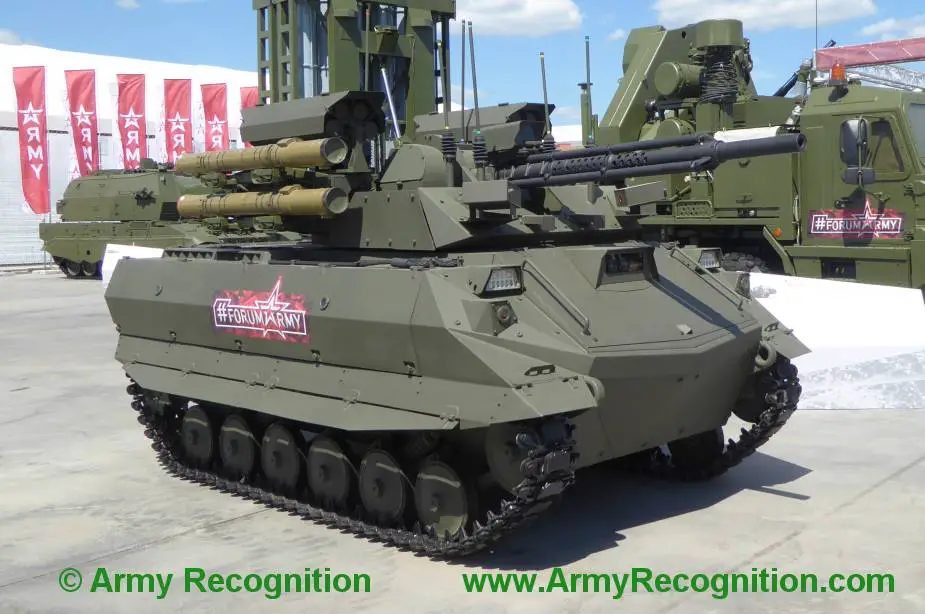Robots need adaptive complex protection – Part 1
The arms system is a cluster of weapons, types of armed forces, and the armed forces in general designed for combat missions. The use of robotic systems is a relatively new component of the Ground Forces, which triggers specific interest. Retired Colonel PhD Technical Sciences V. Bebeshev and Lieutenant-Colonel PhD Technical Sciences D. Metelev research the problem of preserving the capability of ground assault robotic systems in combat in an article in the Voennaya Mysl (Military Thought) journal. They suggest ways to deal with the problem by creating a control system for complex protection based on the theory of functional systems.
Follow Army Recognition on Google News at this link

Uran-9 BMRK reconnaissance and fire support UGV (Picture source: Army Recognition)
The experience of the wars and armed conflicts of the past two decades and the analysis of arms development programs of the potential adversary allow concluding that robotic systems offer a prospective development guideline. Ground robots are specifically vital due to combat actions in the Middle East, where the land forces were actively engaged together with air power. The land forces are the assault force, which ensures the offensive and holding of areas and positions at the final stage of operations and suffers most from the hostile impact.
Ground military robots are a cluster of functionally connected single or several robotic systems and maintenance means operating on the ground. The article considers the problem of protecting assault robots and ways to resolve it.
Ground assault robots fulfill the following missions: advance in the direction of the main strike; hold defense strongholds, and assault residential settlements. The missions pose a major risk for manned hardware and trigger sensible personnel losses.
Military robots have to have corresponding combat capabilities to cope with the missions. Their protection is an important and difficult task. Losses are inevitable in modern combat, but they should be within the limits that ensure successful actions.
As for manned hardware, the protection against conventional arms means the ability to counter hostile weapons and keep the combat capability. It is provided by three groups of methods and means: active counteraction to hostile antitank weapons (main, additional, and auxiliary weapons); decreased kill chance (camouflage, size, maneuverability in the battlefield, reactive armor, electronic and optical jamming, etc.); decreased piercing possibility (armor, reactive armor, fire equipment, etc.).
The use of protection theory for military robots exposes theoretical, practical, and methodological problems. Assault robots have to engage in risky missions for soldiers when the adversary engages a lot of antitank weapons. Besides, the robots are impacted in the electromagnetic field and by various information weapons.
An analysis of weapons and their impact on the design of robotic systems is necessary to form the theoretical basis of the complex protection.
Robots use a lot of electronic devices with modern and sophisticated microelectronics. It makes them vulnerable to radioactive and electromagnetic emissions. The absence of standby manual control of weapons and movement makes the risk critical. Electromagnetic weapons exert the following impact on robots: they affect electronic schemes, onboard information-control systems, and navigational elements and temporarily or finally disrupt their operation; destroy various electronic equipment by changing electro-physical features of materials in the element base; sharply increase the volume of circulating information to disrupt remote control; engage electronic warfare to jam radio, optical, electronic, information, and control channels.
The communication systems of robots have to ensure reliable operation depending on the importance of information guidelines. As a rule, information or cyber impact is based on changes introduced into the software without affecting the hardware. An example is offered by several types of special information impact on robotic complexes: proactive inclusion of certain elements into the software, which independently activate and destroy it. The malfunction can be camouflaged as a natural failure of the equipment; infection with viruses that ruin databases and software; access to communication channels between the robot and remote control and input of fake information, generation of self-destruction command, interception of obtained information and control.
© Copyright 2021 TASS / Army Recognition Group SPRL. All rights reserved. This material may not be published, broadcast, rewritten or redistributed.


























